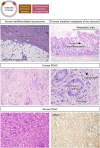In Vivo Reprogramming Highlights Epigenetic Regulation That Shapes Cancer Hallmarks
- PMID: 40259515
- PMCID: PMC12210047
- DOI: 10.1111/cas.70067
In Vivo Reprogramming Highlights Epigenetic Regulation That Shapes Cancer Hallmarks
Abstract
Douglas Hanahan added "non-mutational epigenetic reprogramming" and "unlocking phenotypic plasticity" as new hallmarks of cancer, proposing that cancer cells possess fundamental features that are not directly linked to their genetic abnormalities. In vivo reprogramming studies have demonstrated that non-mutational epigenetic regulation can cause cellular reprogramming, leading to cancer development at the organismal level. Given that epigenetic regulation functions as an interface between the cellular environment and gene expression, these results suggest that intercellular communications in the tumor microenvironment play a critical role in cancer development. This review first introduces genetic aberrations that cause cancer development. Then, it illustrates the impact of epigenetic abnormalities in cancer, especially with reference to studies that use in vivo reprogramming technologies. Finally, it discusses the importance of histological evaluations of tumor tissue to understand non-cell-autonomous epigenetic regulation that establishes cancer hallmarks.
Keywords: cell dedifferentiation; hallmarks of cancer; in vivo reprogramming; non‐mutational epigenetic reprogramming; unlocking phenotypic plasticity.
© 2025 The Author(s). Cancer Science published by John Wiley & Sons Australia, Ltd on behalf of Japanese Cancer Association.
Conflict of interest statement
Yasuhiro Yamada is an editorial board member of Cancer Science. Other authors do not have COI.
Figures




Similar articles
-
[Epigenetics' implication in autism spectrum disorders: A review].Encephale. 2017 Aug;43(4):374-381. doi: 10.1016/j.encep.2016.07.007. Epub 2016 Sep 28. Encephale. 2017. PMID: 27692350 French.
-
Mechanisms governing lineage plasticity and metabolic reprogramming in cancer.Trends Cancer. 2024 Nov;10(11):1009-1022. doi: 10.1016/j.trecan.2024.08.001. Epub 2024 Aug 31. Trends Cancer. 2024. PMID: 39218770 Review.
-
Exploring Epigenetic Complexity in Regulation of Hematopoietic Stem Cells Niche: A Mechanistic Journey from Normal to Malignant Hematopoiesis.Adv Exp Med Biol. 2025;1483:49-67. doi: 10.1007/5584_2024_846. Adv Exp Med Biol. 2025. PMID: 39841383 Review.
-
Interventions targeted at women to encourage the uptake of cervical screening.Cochrane Database Syst Rev. 2021 Sep 6;9(9):CD002834. doi: 10.1002/14651858.CD002834.pub3. Cochrane Database Syst Rev. 2021. PMID: 34694000 Free PMC article.
-
Opportunities for Cellular Rejuvenation in Alzheimer's Disease: How Epigenetic Reprogramming and Chaperone-Mediated Autophagy Are Enabling Next Generation Therapeutic Approaches.J Prev Alzheimers Dis. 2023;10(4):661-668. doi: 10.14283/jpad.2023.106. J Prev Alzheimers Dis. 2023. PMID: 37874086 Review.
References
-
- Group FIS , “Quadrivalent Vaccine Against Human Papillomavirus to Prevent High‐Grade Cervical Lesions,” New England Journal of Medicine 356 (2007): 1915–1927. - PubMed
-
- Fearon E. R. and Vogelstein B., “A genetic model for colorectal tumorigenesis,” Cell 61 (1990): 759–767. - PubMed
-
- Yamagiwa K. and Ichikawa K., “Experimentelle Studie ü ber die Pathogenese der Epithelialgeschw ül ste,” Mitt Med Fac Kaiserl Univ Tokyo 15 (1915): 295–344.
-
- Sugimura T. and Fujimura S., “Tumour Production in Glandular Stomach of Rat by N‐Methyl‐N′‐Nitro‐N‐Nitrosoguanidine,” Nature 216 (1967): 943–944. - PubMed
Publication types
MeSH terms
Grants and funding
LinkOut - more resources
Full Text Sources
Medical

